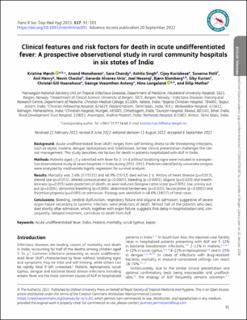Clinical features and risk factors for death in acute undifferentiated fever: A prospective observational study in rural community hospitals in six states of India
| dc.contributor.author | Mørch, Kristine | |
| dc.contributor.author | Manoharan, Anand | |
| dc.contributor.author | Chandy, Sara | |
| dc.contributor.author | Singh, Ashita | |
| dc.contributor.author | Kuriakose, Cijoy | |
| dc.contributor.author | Patil, Suvarna | |
| dc.contributor.author | Henry, Anil | |
| dc.contributor.author | Chacko, Novin | |
| dc.contributor.author | Alvarez-Uria, Gerardo | |
| dc.contributor.author | Nesaraj, Joel | |
| dc.contributor.author | Blomberg, Bjørn | |
| dc.contributor.author | Kurian, Siby | |
| dc.contributor.author | Haanshuus, Christel Gill | |
| dc.contributor.author | Antony, George | |
| dc.contributor.author | Langeland, Nina | |
| dc.contributor.author | Mathai, Dilip | |
| dc.date.accessioned | 2024-03-22T12:51:54Z | |
| dc.date.available | 2024-03-22T12:51:54Z | |
| dc.date.created | 2024-01-09T15:08:00Z | |
| dc.date.issued | 2023 | |
| dc.identifier.issn | 0035-9203 | |
| dc.identifier.uri | https://hdl.handle.net/11250/3123857 | |
| dc.description.abstract | Background Acute undifferentiated fever (AUF) ranges from self-limiting illness to life-threatening infections, such as sepsis, malaria, dengue, leptospirosis and rickettsioses. Similar clinical presentation challenges the clinical management. This study describes risk factors for death in patients hospitalized with AUF in India. Methods Patients aged ≥5 y admitted with fever for 2–14 d without localizing signs were included in a prospective observational study at seven hospitals in India during 2011–2012. Predictors identified by univariate analysis were analyzed by multivariate logistic regression for survival analysis. Results Mortality was 2.4% (37/1521) and 46.9% (15/32) died within 2 d. History of heart disease (p=0.013), steroid use (p=0.011), altered consciousness (p<0.0001), bleeding (p<0.0001), oliguria (p=0.020) and breathlessness (p=0.015) were predictors of death, as were reduced Glasgow coma score (p=0.005), low urinary output (p=0.004), abnormal breathing (p=0.006), abdominal tenderness (p=0.023), leucocytosis (p<0.0001) and thrombocytopenia (p=0.001) at admission. Etiology was identified in 48.6% (18/37) of fatal cases. Conclusions Bleeding, cerebral dysfunction, respiratory failure and oliguria at admission, suggestive of severe organ failure secondary to systemic infection, were predictors of death. Almost half of the patients who died, died shortly after admission, which, together with organ failure, suggests that delay in hospitalization and, consequently, delayed treatment, contribute to death from AUF. | en_US |
| dc.language.iso | eng | en_US |
| dc.publisher | Oxford University Press | en_US |
| dc.rights | Navngivelse-Ikkekommersiell 4.0 Internasjonal | * |
| dc.rights.uri | http://creativecommons.org/licenses/by-nc/4.0/deed.no | * |
| dc.title | Clinical features and risk factors for death in acute undifferentiated fever: A prospective observational study in rural community hospitals in six states of India | en_US |
| dc.type | Journal article | en_US |
| dc.type | Peer reviewed | en_US |
| dc.description.version | publishedVersion | en_US |
| dc.rights.holder | Copyright 2022 The Author(s) | en_US |
| cristin.ispublished | true | |
| cristin.fulltext | original | |
| cristin.qualitycode | 1 | |
| dc.identifier.doi | 10.1093/trstmh/trac091 | |
| dc.identifier.cristin | 2223368 | |
| dc.source.journal | Transactions of the Royal Society of Tropical Medicine and Hygiene | en_US |
| dc.source.pagenumber | 91-101 | en_US |
| dc.identifier.citation | Transactions of the Royal Society of Tropical Medicine and Hygiene. 2023, 117 (2), 91-101. | en_US |
| dc.source.volume | 117 | en_US |
| dc.source.issue | 2 | en_US |
Tilhørende fil(er)
Denne innførselen finnes i følgende samling(er)
-
Department of Clinical Science [2318]
-
Registrations from Cristin [9791]

